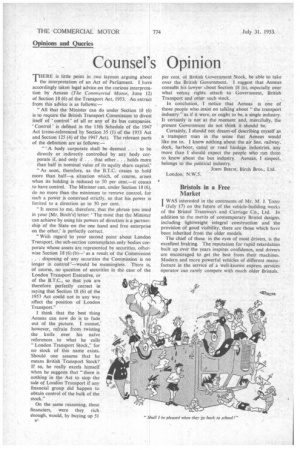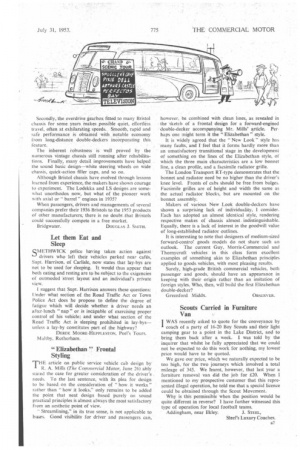Counsel's Opinion
Page 40

Page 41

If you've noticed an error in this article please click here to report it so we can fix it.
THEREis little point in two laymen arguing about 'J 'HERE interpretation of an Act of Parliament. I have accordingly taken legal advice on the curious interpretation by Aeneas (The Commercial Motor, June 12) of Section 18 (6) of the Transport Act, 1953. An extract from this advice is as follows:—
" All that the Minister can do under Section 18 (6) is to require the British Transport Commission to divest itself of control ' of all or any of its bus companies. ` Control ' is defined in the 13th Schedule of the 1947 Act (cross-referenced by Section 35 (1) of the 1953 Act and Section 125 (4) of the 1947 Act). The relevant parts of the definition are as follows:— " ' A body corporate shall be deemed . . to be directly or indirectly controlled by any body cor porate if, and only if . . . that other . . . holds more than half in nominal value of its equity share capital.'
" As soon, therefore, as the B.T.C. ceases to hold more than half—a situation which, of course, arises when its holding is reduced to 50 per cent.—it ceases to have control. The Minister can, under Section 18(6), do no more than the minimum to remove control, for such a power is construed strictly, so that his power is limited to a direction as to 50 per cent.
" It seems to me, therefore, that the phrase you used in your [Mr. Birch's] letter: The most that the Minister can achieve by using his powers of direction is a partnership of the State on the one hand and free enterprise on the other,' is perfectly correct.
"With regard to your second point about London Transport, the sub-section contemplates only bodies corporate whose assets are represented by securities, otherwise Section 18 (6) (b)—' as a result of the Commission . . . disposing of any securities the Commission is no longer in control '—would be meaningless. There is, of course, no question of securities in the case of the London Transport Executive. or of the B.T.C., so that you are therefore perfectly correct in saying that Section 18 (6) of the 1953 Act could not in any way affect the position of London Transport."
I think that the best thing Aeneas can now do is to fade out of the picture. I cannot, however, refrain from twisting the knife over his naive references to what he calls "London Transport Stock," for no stock of this name exists. Should one assume that he means British Transport Stock? If so, he really excels himself when he suggests that "there is nothing in the Act to stop the sale of London Transport if any financial group did happen to obtain control of the bulk of the stock."
On the same reasoning, these financiers, were they rich enough, would, by buying up 51
per cent. of British Government Stock, be able to take over the British Government. I suggest that Aeneas consults his lawyer hbout Section 18 (6), especially over what voting rights attach to Government, British Transport and other such stock.
In conclusion, I notice that Aeneas is one of those people who insist on talking about " the transport industry" as if it were, or ought to be, a single industry. It certainly is not at the moment and, mercifully, the present Government do not think it should be. Certainly, I should not dream-of describing myself as a transport man in the sense that Aeneas would like me to. I know nothing about the air line, railway. dock, harbour, canal or road haulage industries, any more than I should expect the people who run them to know about the bus industry. Aeneas, I suspect, belongs to the political industry.
JOHN BIRCH, Birch Bros.. Ltd. London, N.W.5.
Bristols in a Free Market
I WAS interested in the comments of Mr. M. J. Tozer
(July 17) on the future of the vehicle-building works of the Bristol Tramways and Carriage Co., Ltd. In addition to the merits of contemporary Bristol designs. including lightweight integral construction and the provision of good visibility, there are those which have been inherited from the older models.
The chief of these in the eyes of most drivers, is the excellent braking. The reputation for rapid retardation built up over the years inspires confidence, and drivers are encouraged to get the best from their machines. Modern and mcre powerful vehicles of different manufacture in the service of a well-known express services operator can rarely compete with much older Bristols. Secondly, the overdrive gearbox fitted to many Bristol chassis for some years makes possible quiet, effortless travel, often at exhilarating speeds. Smooth, rapid and safe performance is obtained with notable economy from long-distance double-deckers incorporating this feature.
The inherent robustness is well proved by the numerous vintage chassis still running after rehabilitations. Finally, many detail improvements have helped the sound basic design—white steering wheels on wide chassis, quick-action filler caps, and so on.
Although Bristol chassis have evolved through lessons learned from experience, the makers have shown courage to experiment The Ludekka and LS designs are somewhat unorthodox now, but what of the pioneer work with axial or barrel" engines in 1935?
When passengers, drivers and managements of several companies prefer their 1936 Bristols to the 1953 products of other manufacturers; there is no doubt that Bristols could successfully compete in a free market.
Bridgwater. DOUGLAS J. SMITH.
Let them Eat and Sleep
QMETHWICK police having taken action against " drivers who left their vehicles parked near cafés, Supt. Harrison, of Carlisle, now states that lay-bys are not to be used for sleeping. It would thus appear that both eating and resting are to be subject to the exigencies of outmoded street layout and an individual's private view.
I suggest that Supt Harrison answers these questions: Under what section of the Road Traffic Act or Town Police Act does he propose to define the degree of fatigue which will decide whether a driver needs an after-lunch " nap" or is incapable of exercising proper control of his vehicle;., and under what section of the Road Traffic Act is sleeping prohibited in lay-bys— unless a lay-by constitutes part of the highway? DEREK MOORE-HEPPLESTON, Peel's Tours. Malt by, Rotherham.
"Elizabethan." Frontal Styling
THE article on public service vehicle cab design by
R. A. Mills (The Coounercial Motor, June 26) ably stated the case for greater consideration of the driver's needs. To the last sentence, with its plea for design to be based on the consideration of "how. it works" rather than how it looks," only remains to be added the point that neat design based purely on sound practical principles is almost always the most satisfactory from an aesthetic point of view.
Streamlining,' in its true sense, is not applicable to buses_ Good visibility for driver and passengers can however, be combined with clean lines, as revealed in the sketch of a frontal design for a forward-engined double-decker accompanying Mr. Mills' article, Perhaps one might term it the Elizabethan style.
It is widely agreed that the "New Look" style has many faults, and I feel that it forms hardly more than an unsatisfactory transitional stage in the development of something on the lines of the Elizabethan style, of which the three main characteristics are a low bonnet line, a clean profile, and a facsimile radiator grille.
The London Transport RT-type demonstrates that the bonnet and radiator need be no higher than the driver's knee level. Fronts of cabs should be free from bulges. Facsimile grilles are of height and width the same as the actual radiator blocks, but are mounted on the bonnet assembly.
Makers of various New Look double-deckers have shown a surprising lack of individuality, I consider. Each has adopted an almost identical style, rendering respective makes of chassis almost. indistinguishable. Equally, there is a lack of interest in the goodwill value of long-established radiator outlines.
It is interesting to note that designers of medium-sized forward-contro! goods models do not share such an outlook. The current Guy, Morris-Commercial and Thornyeroft vehicles in this class form excellent examples of something akin to Elizabethan principles applied to goods vehicles, with most pleasing results.
Surely, high-grade British commercial vehicles, both passenger and goods, should have an appearance in keeping with their origin rather than an imitation of foreign styles. Who, then, will build the first Elizabethan double-decker?
Greenford. Middx. OBSERVER.
Scouts Carried in Furniture Van
I WAS recently asked to quote for the conveyance by
coach of a party of 16-20 Boy Scouts and their light camping gear to a point in the Lake District, and to bring them back after a week. I was told by the inquirer that whilst he fully appreciated that we could not be expected to do this work for nothing, my lowest. price would have to be quoted.
We gave our price, which we naturally expected to be too high, for the two journeys which involved a total mileage of 345. We learnt, however, that last year a furniture removal van did the job for 120. When I mentioned to my prospective customer that this represented illegal operation, he told me that a special licence could be obtained through the Scout Movement.
Why is this permissible when the Position would be quite different in reverse? I have further witnessed this type of operation for local football teams.
Addingham, near Ilkley. J. STEEL,
Steel's Luxury Coaches.




















































































